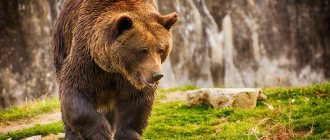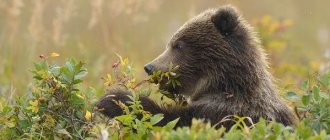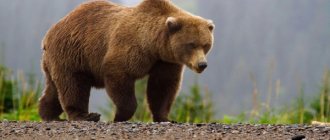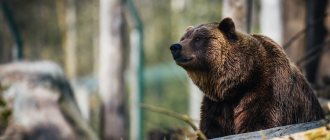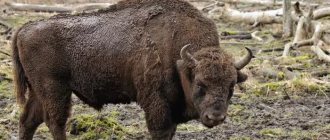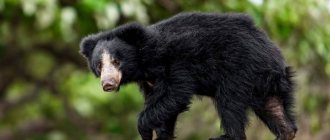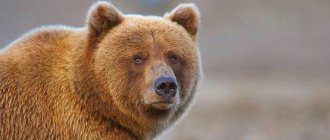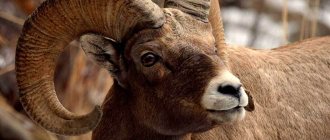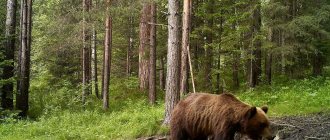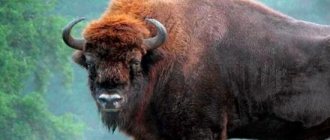One of the largest representatives of the bear family. The body size of the predator can reach two meters in length, and body weight varies from 150 to 350 kilograms. The largest brown bear is the grizzly bear; they can reach up to three meters in length. Such individuals live in Kamchatka and Alaska. The brown bear's head is quite large with small ears. The body is covered with thick and soft fur. The color of the animal can vary from brown to black. As a rule, most representatives are brown in color. The bear's paws are powerful and large, with sharp claws on the fingers.
Animals
The annotated list of the book contains information about living organisms that are rare species or are on the verge of extinction. The Red Book of the Moscow Region includes information about 428 species of animals.
The rapid development of the region with dachas and the demolition of old buildings had a negative impact on the order of bats. Deprivation of their usual habitats and destruction of wintering places reduce the number of pond moths.
Similar reasons affected other representatives of the detachment - northern leatherbacks. Old forests with hollow trees are being destroyed, which forces bats to leave their usual places. Disturbance during hibernation and the death of young animals sharply reduced the population size.
Since the end of the last century, brown bears, which had almost disappeared in the Moscow region, have reappeared. Today, about 1.5 thousand individuals live here. The population of large predators has become a victim of human development and deforestation.
Brown bear
Pond bat Northern leatherback River otter
River otters are considered rare guests. In the fall of 2022, the animal was discovered in the Moscow region. They are classified as vulnerable species, whose numbers are constantly declining. This is facilitated by pollution of water bodies.
The food source for the common lynx is white hares. Reducing the amount of food has a negative impact on predators. Today there are about 30 lynx in the Moscow region. Other limiting factors include land development, increasing packs of stray dogs, and poaching.
Reference. In the spring of 2022, a camera trap captured an adult lynx in the north of the Moscow region. Previously, only traces of predators were found here.
Zoologists have scant information about the hazel dormouse population living in the region. Most often, a small species is found in the Mozhaisk and Ruzsky regions. About 60 individuals were recorded in the mid-20th century. Since then there has been no more accurate information. The reasons for the decline in numbers include the lack of convenient habitats.
Large yellow-necked mice were included in the Red Book in 2008. The length of the animals reaches 10 cm. This amazing rodent prefers to settle in trees no lower than 10-12 meters from the ground. Frosty winters lead to famine, which reduces their numbers. A rare species, but there are points where mice are quite common.
Subterranean voles rarely appear in the region. The rodent, 7-10 cm in size, lives under the canopy of broad-leaved trees. On the territory of the Moscow region, only one habitat is known for sure - the Losiny Ostrov National Park, where mice are protected by law.
Hazel Dormouse Subterranean Vole
Common lynx Yellow-throated mouse
Other representatives of animals of the Red Book of the Moscow Region
Lesser shrew Natterer's bat Russian muskrat Greater jerboa
Speckled ground squirrel Common flying squirrel
A species of brown bear
Brown bears are distinguished by their size and appearance. The most famous subspecies of bears:
European brown bear. A large predator weighing up to 300 kilograms. The coat is pale with a dark spot at the withers.
East Siberian brown bear. The species is distinguished by its soft and long fur. Fur color can vary from light brown to dark brown. In addition to its color, the bear is very massive; its weight can reach 350 kilograms.
Amur brown bear or grizzly bear . The largest predator of the bear family with a mass of 450 kilograms. The fur color is predominantly black.
Caucasian brown bear. Has a small light brown coat. Slightly smaller than its relatives. The weight of the Caucasian bear varies up to 150 kilograms.
Birds
The first edition of the Red Book of the Moscow Region contained information about 62 species of birds. Today the list has been supplemented with 7 more rare birds.
The Moscow region has become the home of the little bittern. For nesting, it chooses overgrown banks of ponds with standing water. The secretive bird is nocturnal. It feeds on small fish, crustaceans, and amphibians. Winters in warm countries, added to the second edition of the book.
Small peregrine falcons are classified as category 0, as birds that have disappeared from the nesting grounds. Today, only migrating individuals are recorded in the Moscow region. There have been no reports of existing populations since 1970.
Additional Information . Peregrine falcons are the fastest birds in the whole world. When diving, they reach speeds of up to 320 km/h. In normal flight, only a swift can overtake him.
Whooper swans are considered an endangered species in the region. Reliable information has been received about only one pair, discovered in 2006. Swans are extremely sensitive to their habitat conditions, which is the reason for their extinction. In the Moscow region they have been under special protection since 1978.
Whooper Swan Peregrine
Little bittern
Another bird population is in danger of extinction. These are pintail ducks. Until 2007, nesting was noted on the Moscow River. The decline in the number of ducks was caused by the overgrowing of pastures and meadows with tall weeds, climate change and wintering conditions.
Gray geese are classified as Category 0 as probably extinct. Until 1970, birds nested everywhere in the region. Today they are spotted during spring migrations in the Voskresensky, Taldomsky, Lotoshinsky districts as single individuals.
Ornithologists note that of the total mass of flying birds, the number of gray geese is 0.7%. The reasons for the decline include human activity, drainage of swamps, and shooting by hunters.
Coniferous forests near swamps are favored by rare species of hawk owls. In the spring of 2007, a nesting pair with three chicks was recorded. After this, only a few individuals were encountered. The limiting factors were direct destruction, disturbance during brooding, deforestation, and climate change.
Hawk Owl Gray Goose Pintail
Lesser terns from the gull family have received Category 1 status as endangered. One pair was discovered in the Moscow region in the spring of 2008. The population size has sharply declined since the 1980s due to human cultivation of habitats, disturbance, death of young animals, and attacks by predators. Today there are no more than 10 pairs of nesting terns in the Moscow region.
Among the probably extinct species are birds of amazing beauty - rollers. The species has always been a rare visitor to the region. The number of colonies dropped sharply by 1990 throughout Europe due to climate change and deteriorating quality of life. Treating the region with pesticides against insects, depriving the birds of food supply, led the population to disaster.
Trees near water bodies are favored by a few colonies of black kites, the numbers of which are constantly declining. To date, ornithologists have noted 200-300 pairs of birds of prey. Pollution of water bodies leads to a decrease in the number of fish, depriving kites of food, which has become a limiting factor.
Black Kite Little Tern Roller
Lesser grebes are a very rare species. Only a few individuals were found on the lands near Moscow. No stable populations were noted in the region, which was facilitated by the initially low number of ducks and the disappearance of small bodies of water for habitat. Since the 80s of the last century, they have been under special protection in the Moscow region.
A rare species of morodunka lives in the region non-permanently. Over the last decade, nesting in the Lukhovitsky and Leninsky districts has become known. Today there are no more than 150 pairs. To live, they need bare areas of land, so widespread overgrowing of the soil in their habitats sharply reduces the number of morodunka.
Klintukh
Little Grebe Morodunka
The mid-20th century was marked by a decrease in the number of clintuhas from the pigeon family. Today the species is considered rare throughout the region. Limiting reasons include the disappearance of mature forests, the use of chemical fertilizers, land development, and death from predators.
Other representatives of birds of the Red Book of the Moscow Region
White stork Black-throated loon
Red-necked Grebe
Black Stork Lesser Lesser Lesser Lesser Lesser Lesser Gray Duck Meadow Harrier Honey Buzzard Osprey Hen Harrier
Steppe Harrier Snake Eater
Golden eagle
Lesser Spotted Eagle Pygmy Eagle
Greater spotted eagle Saker falcon White-tailed eagle Ptarmigan
Merlin Red Falcon Shepherd Little Crake Gray crane Oystercatcher Herbalist Great snipe Great snipe
Lieutenant
Turukhtan
Great Godwit Great Curlew
Lesser Gull Dubrovnik Eagle Owl
Great Tawny Owl Little Owl Great Gray Owl
Green Woodpecker Common Kingfisher Hoopoe
Prince Common Remez Garden Bunting Hawk's Warbler Nutcracker Aquatic Warbler
wood lark
Gray Shrike Middle Spotted Woodpecker
Lifestyle and social organization
Brown bears, unlike white ones, are mostly sedentary. Each individual plot occupied by one animal can be very extensive, covering an area of up to several hundred square meters. km. The boundaries of the plots are poorly marked, and in very rough terrain they are practically absent. The home ranges of males and females overlap. Within the site there are places where the animal usually feeds, where it finds temporary shelters or lies in a den.
In permanent habitats of bears, their regular movements around the area are marked by clearly visible paths. They are similar to human paths, only unlike them, along bear paths there are often scraps of bear fur hanging on the branches, and on the trunks of particularly noticeable trees there are bear marks - bites with teeth and bark torn off by claws at the height that the animal can reach. Such marks show other bears that the area is occupied. The trails connect places where the bear is guaranteed to find food. Bears place them in the most convenient places, choosing the shortest distance between objects that are significant to them.
A sedentary lifestyle does not prevent the bear from making seasonal migrations to places where food is currently more accessible. In lean years, a bear can travel 200-300 km in search of food. In the flat taiga, for example, animals spend the summer in clearings overgrown with tall grass, and in early autumn they flock to the swamps, where they are attracted by ripe cranberries. In the mountainous regions of Siberia, at the same time they move to the char zone, where they find an abundance of dwarf pine nuts and lingonberries. On the Pacific coast, during the mass migration of red fish, animals come from afar to the mouths of rivers.
A characteristic feature of the brown bear, common to both males and females, is winter sleep in a den. Dens are located in the most secluded places: on small islands among moss swamps, among windbreaks or dense small forests. Bears most often arrange them under inversions and logs, under the roots of large cedars and spruce trees. In mountainous areas, earthen dens predominate, which are located in rock crevices, shallow caves, and recesses under stones. The inside of the den is arranged very carefully - the animal lines the bottom with moss, branches with pine needles, and tufts of dry grass. Where there are few suitable places for wintering, dens used for many years in a row form real “bear towns”: for example, in Altai, 26 dens were found in a 10 km long segment.
In different places, bears sleep in winter from 2.5 to 6 months. In warm regions, when there is an abundant harvest of nuts, bears do not lie down in a den for the entire winter, but only from time to time, under unfavorable conditions, they fall asleep for several days. Bears sleep alone, only females who have young yearlings sleep together with their cubs. During sleep, if the animal is disturbed, it easily awakens. Often the bear itself leaves the den during prolonged thaws, returning to it at the slightest cold snap.
Insects
The list of insects included in the Red Book of the Moscow Region includes 299 taxa. Of them:
- butterflies – 198 species;
- beetles - 33 species.
In the new 2022 edition, 246 species of insects remain.
Butterflies with the unusual name mayor's winged eyes are considered possibly extinct in the region. Insects inhabited the Losiny Ostrov National Park.
The population was initially low in size. Secretive butterflies avoid people and hide among the foliage when threatened. The cutting down of pine forests, scaring during the breeding season, and fires have made a negative contribution to the life of the edge-eye. Today the species is not registered within the borders of Moscow.
The number of imperial watchmen is greatly reduced. In many areas, dragonflies have been lost for 30 years. Information about 7 points where no more than 6 individuals were observed was reliably confirmed. The decline is affected by the small number of convenient reservoirs, their pollution, and the destruction of coastal vegetation.
Close to the critical point are bright golden-green smooth bronzes. The 2cm beetles prefer old trees. Reducing the area of mature forests and cutting down hollow trees reduces suitable habitats. The number of bronzebacks in the Moscow region is extremely low.
Oriental sawtail Mayor's corner-eye Bronzovka smooth Watchman-emperor
Eastern sawtails love meadows with lush forbs. The number of grasshoppers is constantly fluctuating. There are years of complete absence of insects. The highest number was recorded near the village of Kurebino. Here, in an hour of searching, 8 copies were found. More often, only single individuals are found, which is facilitated by haymaking, grazing, steppe fires, and floods.
The southern regions are favored by Norway wasps, a rare species in the region. Three populations have been recorded here. The reasons for the decline in the number of insects include the destruction of nests by humans and climate change. No sharp fluctuations in numbers were noted.
Euphorbia cocoon moths lived in dry meadows and the edges of pine forests. Butterfly taxa were recorded in the Saltykovsky, Mistsevsky, and Mikhnevsky districts. Over the past 3 decades, the existence of these populations has not been confirmed. After 2010, one caterpillar was discovered near the village of Podmoklovo, two butterflies near Marinka, and a colony of caterpillars near the Danilovskaya railway station. Limiting factors include plowing of land, haymaking, and grazing.
The number of green rockers from the order of dragonflies has greatly decreased. Insects prefer muddy ponds overgrown with reeds. The finds were noted in the Lyubertsy region. Other areas please only with single specimens. The number of dragonflies is decreasing due to the rarity of convenient reservoirs, their pollution, and destruction of vegetation.
Euphorbia cocoon moth Green rocker Norway wasp Forest racer
Forest Coleoptera racers are bronze-black in color and reach a size of 1.5-2 cm. They are found sporadically near Lake Glubokoe in the Ruza region. Since 1988, the number of beetle habitats has greatly decreased. Deforestation, construction of summer cottages, and recreational activities deprive insects of suitable habitats.
Other representatives of insects in the Red Data Book of the Moscow Region:
Swallowtail Spring dung beetle Broad-winged beetle Callistus lunar Ophonus indistinct Golden ground beetle Blue-winged filly Crackling firefly Broad-winged rattle Wingless filly Dark-winged filly Spotted javelin
Short-winged swordsman Pine sawtail White-haired rocker
Features of behavior when meeting a bear
When moving through the taiga where there are bears, you need to make at least a little noise - talk, hum, whistle, crack branches while walking, etc. These precautions are enough for the animal to hear or smell people from afar and in advance, and therefore calmly, without panic and fear, which is precisely what is dangerous, got out of their way.
When a meeting with a bear does occur, and he does not run away, this most likely means that the animal sees a person, is alarmed, but has not yet decided what to do. It is quite possible that he mistakes the person for a deer and hopes to drive him away with his angry “puffery”. Sometimes he can make 2-3 lunges - a throw several meters towards a person, while occasionally rearing up and roaring.
It is necessary to calmly, at a pace, but quickly enough to move to the side, while trying to be on the windward side so that the bear can smell the person. If this is not possible, you need to move away from the probable direction of movement of the animal, while raising your voice - screaming, speaking loudly.
It is possible that in front of you is a bear with cubs nearby. If there are trees nearby, they will most likely be on one of them. When leaving, you should look around so as not to go in their direction.
If the animal is close to a person, at 10-15 m, it is not recommended to look him directly in the eyes. For many large predators, a direct gaze is a signal of threat, an invitation to fight. Therefore, look at him not directly and point-blank, but sideways, and not all the time, but with pauses.
If the bear, despite this behavior of yours, does not run away, but approaches, and even looks straight at you, without turning his head or looking to the side, you urgently need to look for a suitable tree and, without hesitating at all, climb higher. If you have a basket, a bag, a hat on your head or a backpack on your back, throw it to the beast.
Reptiles
Today, 7 species of reptiles live on the territory of the Moscow region, some of which are included in the Red Book. Among them:
- Common copperhead.
- Viper.
- An ordinary one.
One of the rare species for the region is the common copperhead. Reptiles are on the verge of extinction. The last individuals were discovered in 1983. The destruction of the food supply, death at the hands of a person who considers the copperhead poisonous, and the destruction of habitats became the reasons for their disappearance.
Snakes 75-80 cm long with a zigzag pattern are common vipers and lead a sedentary life. They rarely crawl further than 50 meters from their habitat. Reptiles are classified as category 2 declining species. The reasons for the decrease in number include deforestation, habitat development, and direct destruction by humans. In the region the snake lives in local populations.
Important! When encountering a deadly poisonous viper, there is no need to make sudden movements or prevent it from leaving. When walking in the forest, you must wear closed clothing and boots.
Limited populations of common grass snakes remain in the region. Most of the snakes live in the Losiny Ostrov National Park. In other areas they occur as single specimens.
In the Izmailovsky massif, the last sighting of snakes was recorded in the summer of 2010. The reasons for the extermination of snakes were the development of the Moscow region, pollution of water bodies, death on the roads, and fires.
Common viper Common copperhead Common grass snake
Hibernation of brown bears
The brown bear's hibernation period begins with the onset of cold weather. The bears begin to prepare their dens for a long sleep. Hibernation shelters are built in remote places on windbreaks. Bears are also capable of digging large holes or settling in mountain caves. Females with children try to make their den warm and spacious, lining it with moss and spruce branches.
Depending on climatic conditions, bears can hibernate for up to six months. Pregnant and elderly animals are the first to leave for the winter.
Amphibians
The region's book contains information about 4 species of rare and endangered amphibians.
The brittle spindle is often confused with a snake. The latest discoveries of amphibians date back to 2000 on Losiny Island. Scientists suggest that the species is still preserved in these areas. But there is no verified data.
The number in the region is extremely low, due to the influence of anthropogenic human activity and the unauthorized construction of a sports complex in the national park.
Over the past decade, the number of sand lizards has decreased. In favorable areas, the habitat density ranges from 20 to 130 individuals per hectare. The average density is from 0.5 to 7 specimens per 1 hectare. Habitat destruction, human economic activity, and packs of stray dogs have negatively affected the lizard population.
The amazing crested newts, decorated with a jagged crest along their entire length, are gradually disappearing from the region. Today, the number of amphibians is generally low. Newts die from attacks by rats, destruction of their usual habitats, land development, and pollution of lakes and rivers with chemicals. Tritons have been assigned category 2 status.
Sand lizard Brittle spindle Crested newt
For the Moscow region, green toads were a common species at the beginning of the 20th century. Today their numbers are extremely low. The toad easily tolerates a lack of moisture, but the destruction of habitats, wintering grounds, and catching for educational purposes exterminate a large number of green toads, transferring them to the category of rare animals.
The most secretive amphibian is considered to be the common spadefoot, which secretes a secretion with a pungent odor of garlic. Today, the number of encounters with the toad has dropped sharply. Deterioration in the quality of water for breeding, predators, and habitats destroyed during the construction of roads and pipelines have become limiting factors.
Tailless fire-bellied fire-bellied fire-bellied toads are considered to have practically disappeared from their former places. Frogs are classified in category 2. As a result of economic activities, suitable places are destroyed. By catching them for sale, predators deprive the fire-bellied toads of any chance of survival.
Common spadefoot
Red-bellied Toad Green Toad
Nutrition and feeding behavior
The brown bear is a true omnivore, eating more plant food than animal food. It is most difficult for a bear to feed itself in early spring, when plant food is completely insufficient. At this time of year, he hunts large ungulates and eats carrion. Then he digs up anthills, getting larvae and the ants themselves. From the beginning of the appearance of greenery until the mass ripening of various berries, the bear spends most of its time fattening on “bear pastures” - forest clearings and meadows, eating umbelliferous plants (hogweed, angelica), sow thistle, and wild garlic. From the second half of summer, when the berries begin to ripen, throughout the forest zone bears switch to feeding on them: first blueberries, raspberries, blueberries, honeysuckle, later lingonberries, cranberries. The autumn period, the most important period for preparing for winter, is the time to eat tree fruits. In the middle zone these are acorns, hazelnuts, in the taiga - pine nuts, in the mountainous southern forests - wild apples, pears, cherries, and mulberries. The bear's favorite food in early autumn is ripening oats.
Eating grass in a meadow, the bear peacefully “grazes” for hours, like a cow or horse, or collects the stems it likes with its front paws and puts them in its mouth. Climbing fruit-bearing trees, this sweet tooth breaks off branches, eating the fruits on the spot, or throws them down, sometimes simply shaking the crown. Less agile animals graze under the trees, picking up fallen fruits.
The brown bear willingly digs into the ground, extracting succulent rhizomes and soil invertebrates, turns over stones, extracting and eating worms, beetles and other living creatures from under them.
Bears living along rivers along the Pacific coast are avid fishermen. During the course of the red fish, they gather in dozens near the rifts. While fishing, the bear goes belly-deep into the water and with a strong, quick blow of its front paw, throws a fish that has swam close to the shore.
The bear hides large ungulates - deer, elk - completely silently approaching the victim from the leeward side. Roe deer sometimes lie in wait along trails or at watering holes. His attack is swift and almost irresistible.
Fish
The reservoirs of the Moscow region are included in the Volga basin. There are about 50 species of ichthyofauna here.
Among the cyclostomes, European brook lampreys are found. Accurate information on the number of fish has not been revealed. What is known is that it is constantly decreasing. Sewage pollution and uncontrolled mining have made a negative impact on the life of the lamprey.
In the last century, the waters of the Oka were famous for their large reserves of commercial sterlet. By the beginning of 2000, the number had sharply decreased, which was facilitated by river pollution, poaching, and gravel mining, which disrupts spawning grounds. Today, the number of sterlet has been increased in the Moscow River basin through artificial breeding by the Mozhaisk plant.
European brook lamprey Sterlet Chekhon
Chekhon is considered a rare species for the region. Several cases of catching the species have been recorded on the Moscow River. Today the number of fish is limited. Limiting factors include poachers, natural death of sabrefish, and climate change for the heat-loving breed.
European grayling stocks are at a low level. There are several hundred of this species here; more accurate data is not available. Grayling is very sensitive to the purity and quality of water. Dirty reservoirs and illegal fishing are causing the disappearance of grayling.
Predatory asps love solitude. Large individuals were spotted in the Mozhaisk and Khimki reservoirs and the Moscow River. Depletion of reserves occurs due to sewage discharge, silting of rivers, strengthening of banks with concrete, which disrupts the natural environment of reservoirs. Since 2001, the asp has been included in the Red Book of Moscow as a vulnerable species.
Regular catches of rare bluefish have been recorded on the Oka River. The fish is found in single specimens. Due to the small population, illegal mining sharply reduces the reserves of blue.
Reference. Decree of the Government of the Russian Federation No. 1321 of November 13. In 2022, taxes have been set to compensate for damage caused to the biological resources of water bodies, regardless of the number and size of fish caught.
European grayling Blue Asp
Other representatives of the fishes of the Red Data Book of the Moscow Region
White-eye Russian bystryanka Common podust Bersh Common sculpin Common catfish
Lifestyle and habitat
The forest dweller prefers areas with windbreaks, dense growth of grasses and shrubs in burnt areas. Mountain regions, tundra, and coastlines are also developed by the predator. Once upon a time, the widespread distribution of the brown bear was recorded from England to Japan.
But changes in inhabited territories and the extermination of the beast led to a significant compression of the range. The forest zones of western Canada, Alaska, and the Russian Far East are its main habitats.
Each bear has a separate territory, ranging in size from 70 to 140 km², marked by smells and noticeable scratches on the trees. The male's area is 7 times larger than that of the female. The territory is defended from strangers. The separated young animals, in search of a partner, can actively wander beyond the boundaries of the site.
The predator is active during daylight hours, often in the early morning and evening. In search of food, the sedentary animal sometimes makes seasonal movements, following to areas where berries and nuts ripen.
Despite the large size of the animal and its clumsy appearance, the predator runs quickly. The average speed of a brown bear is 50-60 km/h. The physical activity and plasticity of the animal is manifested in the ability to climb trees, swim across rivers, and cover significant distances.
The bear has the ability to approach prey silently and with light movements. With a strong blow of his paw he can break the back of a deer or wild boar.
The sense of smell allows the animal to smell the decomposition of meat 3 km away. Hearing is acute. The bear often stands up on its hind legs and listens to its surroundings, catching smells. A difficult obstacle for a bear is deep snow cover.
The life of a predator has a seasonal cycle. In the summer, well-fed bears rest on the ground, among herbs, bask in the sun, and take care of their offspring. In the fall, they are busy looking for a winter shelter, arranging it, and accumulating subcutaneous fat.
In winter, a deep sleep occurs, which lasts from one month to six, depending on many factors. It is interesting that the physiological parameters of the animal (pulse, temperature, etc.) practically do not change, unlike other mammals.
Spring awakens weakened animals. Weight loss over the winter can be quite significant - up to 80 kg. The accumulation of strength for a new life cycle begins.
Plants
The region is home to 19 plant species listed in the book.
Category 4 includes reddish pondweed. The plant has received an uncertain status due to the difficulty of studying it. Only two places of growth have been discovered near Moscow. Today, the size, condition of the population, and limiting factors have not been precisely established. Ecologists suggest that pondweed is extremely demanding on the purity and quality of water.
Siberian buzulniks grow in limited areas in small populations. They are found in single specimens in the Losiny Ostrov National Park. The herbaceous perennial 150 cm high is disappearing due to the draining of swamps, deforestation, and plowing of fields.
The scientific name of everyone's favorite daisies is common daisy. They inhabit open areas, meadows, and clearings. Can grow on disturbed soils. Plants with large inflorescences, which so attract attention, have practically disappeared near Moscow.
Siberian buzulnik Common cornflower Common pondweed
The medicinal auranas that inhabited the Oka Valley are considered rare. The plant has an initially low population, which continues to decline. The plowing of floodplain meadows, the destruction of thickets along river banks, pastures, and the collection of grass for medicinal purposes gradually leads to the disappearance of the grass.
Until recently, spring primroses grew everywhere. An early flowering perennial found along the edges and clearings near forest areas. Now their numbers are sharply declining. Development and improvement of territories, collecting for bouquets, trampling, soil compaction leads to the loss of the species.
The southern borders of the region are favored by grass burrs. The plants first became known in 1903. On the territory of the Moscow region, 6 growing points have been noted. But their existence has not been reliably confirmed. Only near Lake Glubokoe in the Ruza region the population condition is assessed as stable.
Avran officinalis Grass hedgehog Spring primrose
Reference. According to the Moscow City Code, fines of up to 3 thousand rubles are provided for illegal collection and trade in Red Book plants.
Other representatives of plants of the Red Book of the Moscow Region
Common coffin Common centipede Salvinia floating
Horsetail
Lakeland grass Sheichzeria swamp Feather feather feather
Sedge two-rowed Cinna latifolia Dwarf birch Black hellebore
Bear onion Hazel grouse checkered
Spring adonis Sandy carnation Lesser egg capsule Oak wood anemone Clematis straight
Creeping buttercup Cloudberry English sundew
Peasant peas Field maple Yellow flax
Marsh violet
Wintergreen medium St. John's wort graceful Tartarian ragus
Sphagnum obtuse Skerda Siberian Aster Italian Altai bellflower Blue honeysuckle
Pemphigus intermedia
Sage sticky
Veronica
Bear cubs
Teddy Bear
In winter, tiny babies are born in the mother bear's den. As a rule, the birth period for cubs is in January. All winter, the babies suckle the milk of their sleeping mother, who, however, often wakes up to take care of her babies. Babies grow quite slowly. Their ear openings become noticeable 2 weeks after birth. Newborn cubs weigh 300 - 400 grams. Only after a month do their eyes open.
Until this time, the cubs lie motionless near their mother. By the time they leave the den, they gain weight up to 5 - 7 kilograms. Babies are breastfed for up to 6 months, but they begin to eat plant foods as early as 3 months. The cubs spend their first winter with their mother. The cubs stay with their caring mother for three to four years, and you can meet a mother bear with a litter of cubs of different birth years.
Although the brown bear is a formidable predator, capable of taking down elk or other large game, it usually feeds on berries, nuts, fruits, tender parts of plants, bird eggs, honey, rodents, fish, even insects. This is truly an omnivorous animal. The bear does not even disdain carrion, as well as taking prey from other predators. For example, wolves. When salmon spawn on Siberian rivers, bears are right there. There are so many fish that it is not difficult for a mighty beast to pick up another fish from the water with its paw. When there is not much prey in natural conditions, the bear may attack livestock. In spring they prefer young needles and grass.
In summer, when the grass becomes coarser, the bear chooses juicier plants and berries. In autumn he eats nuts and all kinds of fruits. The plant diet is replenished with insects, small rodents, bird eggs - everything that can be obtained without much effort. Bears become predators out of necessity. Mainly in the spring, when plant food is still scarce. The blow of a bear's paw is so strong that it can break the skull of even an elk.
- During hibernation, a brown bear's heartbeat slows down to 7-9 beats per minute.
- In old age, bears lose their teeth, since it is more difficult for them to catch prey and they feed mainly on plant foods. It is tougher and the teeth wear out faster.
- Bears have excellent memory. He always remembers places rich in mushrooms and berries.
- In times of famine, the brown bear feeds on carrion.
- Bear's milk is superior in fat content to cow's milk.
- Only young bears climb trees.
- A brown bear can accelerate to a speed of 50 km per hour.
- A bear marks its territory by stripping bark from trees.
- Before hibernating, the bear gains weight, up to two hundred extra kilograms.
- A brown bear can kill a large animal with one blow of its paw.
The brown bear usually inhabits forests. It can be found in open mountain areas and in the subpolar tundra. In Russia, the animal prefers the wilderness, forests heavily overgrown with young growth. The bear is the real owner of the forest, he has no enemies except humans, and he is not afraid of anyone. The predator leads a solitary lifestyle, an exception to this rule is a female bear with cubs. Solitary bears mark their territory in the forest by stripping the bark of border trees. For neighbors it’s like a barrier on the border. The bear family includes 5 genera and 8 species of animals. From small Malayan bears, weighing from 30 to 65 kg, to huge polar bears. Their body weight sometimes exceeds 1000 kg.
Mushrooms
The mushrooms listed in the book are protected. Illegal collection implies administrative punishment. The list includes 22 species, including 5 new ones included in the latest edition.
Rare, local colonies are found in yellow marsh mushrooms with a cap up to 12 cm in diameter. The edible mushroom has been known since the beginning of the 20th century. The marsh bog is classified as category 4 of uncertain status. The number and limiting factors have not been studied.
Chestnut grass Yellow marsh grass Cone-shaped fly agaric
The cap of the edible chestnut tree grows 10 cm. The flesh is white with a distinct mushroom taste. Prefers to grow on broad-leaved trees and sandy soils in single specimens. The population size is low, which is facilitated by the destruction of habitats, deforestation, and the collection of chestnut trees by the population.
Calcareous soils are favored by rare cone-shaped fly agarics. Cones are scattered across the cap of large mushrooms, hence the name. Fly agarics have a narrow growing area. The reasons for the low numbers and limiting factors are unknown.
The elegant grilles look like a work of art. The inedible species lacks a cap and a stem. Extremely rare mushrooms for the Russian Federation. In the Moscow region, one case of ripening of the lattice grass was registered.
The status of rare mushrooms is assigned to large white aspen trees, reaching 20 cm. In the Moscow region, they were found in the Odintsovo, Serpukhov, and Mozhaisk districts. Small colonies consist of 2-3 copies. The edible mushroom is collected at the foot of birch and coniferous trees. Uncontrolled collection and destruction of growing areas make a negative contribution.
Purple White aspen Lattice
The amazing color of the spider web purple attracts attention. Small mushrooms usually grow near swampy areas. Violets are extremely rare in the region. The latest find dates back to 2016 in the Orekhovo-Zuevsky district, although the fungus had not been observed here before.
Other representatives of mushrooms from the Red Book of the Moscow Region
Gyroporus blue Sparassis curly Polypore branched
Chestnut flywheel Violet cobweb Semi-white mushroom Marsh milk mushroom Coral blackberry Turkish russula
Scaly cobweb
Berezovik pinkish Russula red
Mating season and offspring
The breeding season for brown bears traditionally falls in May. Estrus in females lasts more than 20 days. This period is characterized by serious conflicts between males. The winner of the fight gets the right to fertilize the female. The couple stays together for 40 days. The gestation period lasts on average 7 months. As a rule, 2-3 bear cubs are born to the brown family. The offspring stay with their mother for up to three years, and feed on mother's milk for up to a year.
The father of the cubs does not participate in their upbringing. All responsibility falls on the mother.
